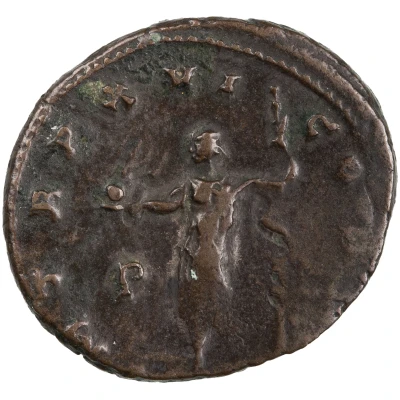


© American Numismatic Society (ANS)
Antoninianus - Gallienus P M TR P XVI COS VII
268 year| Silver | 3.4 g | 20.5 mm |
| Issuer | Rome › Roman Empire (27 BC - 395 AD) |
|---|---|
| Emperor | Gallienus (Publius Licinius Egnatius Gallienus) (253-268) |
| Type | Standard circulation coin |
| Year | 268 |
| Value | Antoninianus (1) |
| Currency | Antoninianus, Reform of Caracalla (AD 215 – 301) |
| Composition | Silver |
| Weight | 3.4 g |
| Diameter | 20.5 mm |
| Shape | Round (irregular) |
| Technique | Hammered |
| Demonetized | Yes |
| Updated | 2024-10-05 |
| Numista | N#289269 |
|---|---|
| Rarity index | 100% |
Reverse
Gallienus, standing left, holding globe in right hand and sceptre in left hand.
Script: Latin
Lettering: P M TR P XVI COS VII
Translation:
Pontifex Maximus, Tribunicia Potestate Sexta Decima, Consul Septimum.
High priest, holder of tribunician power for the 16th time, consul for the seventh time.
Comment
Example of this type:American Numismatic Society (ANS)
Source:
Online Coins of the Roman Empire (OCRE)
Interesting fact
The Antoninianus coin was issued during the reign of Gallienus, who was the Roman Emperor from 260 to 268 AD. During his reign, the Roman Empire was facing numerous challenges, including invasions by barbarian tribes and internal conflicts. Despite these challenges, Gallienus was able to maintain the empire's stability and issue coins like the Antoninianus, which were used for trade and commerce. It's interesting to note that the coin is made of silver, which was a valuable resource at the time. The fact that it weighs 3.4 grams suggests that it was a significant amount of silver, and its production required a certain level of craftsmanship and resources. Overall, the Antoninianus coin is a fascinating piece of history that provides insight into the economic and political conditions of the Roman Empire during the 3rd century AD.